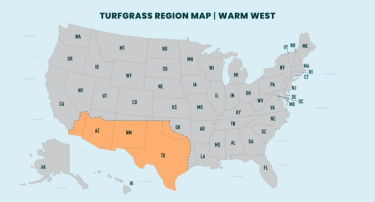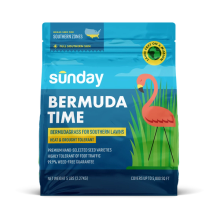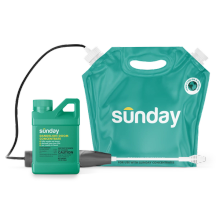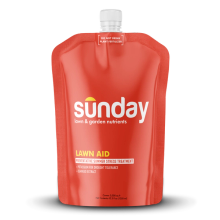The western warm-season region
Warm-season lawns are common throughout the warmer southern regions of the western U.S., including: Arizona, New Mexico, Texas, and southern California and Nevada.
Warm-season grasses can also be grown in parts of the transition zone in the West. This includes portions of Kansas, Oklahoma, and southern Colorado, Nebraska, and Utah.

Warm-season grass types
Warm-season grasses in the West include the following:
- Bermudagrass
- Zoysiagrass
- St. Augustinegrass
- Kikuyugrass
These grasses grow best in the warmer summer months, when temperatures are between 80 and 95ºF, and may go dormant in the winter if temperatures regularly drop below 50ºF.
You might also see the occasional buffalograss, bahiagrass, or paspalum lawn, but these are not super common in this region.
Growing warm-season grass in the West
Even though warm-season grasses are better adapted to heat and drought than their cool-season counterparts, in the summer, supplemental watering may still be required out West to keep the grass green. Train your lawn to use less water and be sure to audit your irrigation system to ensure you’re not wasting any precious water.
In the winter, these grasses may go dormant or be susceptible to cold damage (or even winter kill), particularly in the cooler regions of the transition zone where temperatures can drop below freezing. Because of this, they may also be a little slower to green up in the spring than some of the cool-season grasses.
Plant warm-season grasses in the summer to crowd out weeds, fill in bare spots, and improve the overall health and appearance of your lawn. Remember: Not all warm-season grasses can be grown from seed, and you might have to use sod, sprigs, or plugs instead.
Sunday Tip:
We love lawns, but sometimes, grass isn’t the right fit for the yard. If you’re facing watering restrictions or just want to reduce water use, consider letting your grass go gold during dry periods, or plant drought tolerant alternatives in place of some of your grass.
Lawn care help for warm-season grass in the West
Deciding what products to use to help your lawn thrive can be tricky. Using the tips above, start by narrowing in on the opportunities or challenges in your unique lawn. Are you dealing with patches, dry spots, weeds, or something else? The most important things to consider when determining what help your lawn might need is what type of grass you are growing and how healthy your soil is.
Here are some of our go to products for the West that you can get shipped to your door from Sunday!

Bermuda Time Common Bermudagrass Seed
- Heat & drought tolerant
- High sunshine
- Low water needs

Dandelion Doom Lawn Weed Killer - Starter Pack
- Kills weeds down to the root
- Safe for use on lawns
- See results within hours

Lawn Aid Heat Stress Prevention Treatment
- 0-0-3 Preventative fertilizer
- Increases resilience
- Improves moisture retention
Resources for warm-season lawns in the West
Warm-Season Lawn Care Guide
Not sure what you should be doing in your lawn season-to-season? Our warm-season lawn care guide offers month-by-month to-dos to make lawn care easy.
How to Deal with Summer Water Restrictions
As more areas – especially out West – face increased drought severity and dwindling water supplies, water restrictions are becoming more and more common. Learn how to manage a lawn under summer water restrictions.
How to Make a Rain Barrel
Thinking about setting up a rain barrel, but not quite sure where to start? Use this how-to for tips on setting up and maintaining rain barrels to help supplement your water supply.
NPK for Lawns
What do those 3 numbers (N-P-K) on your fertilizer bag mean? Nitrogen (N), phosphorus (P), and potassium (K) are the nutrients your grass needs most in order to grow healthy and dense.
Weed ID Guide
Got weeds? Our weed ID guide can help you identify your lawn weeds, so you can better target your weed management approach.












